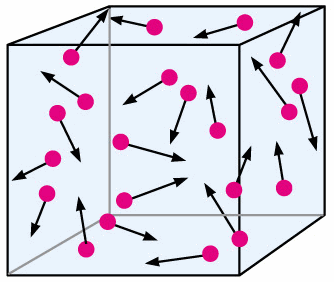Motion of Molecules
The idea that molecules are in constant motion was proposed by the kinetic theory of gases. The development of this theory in the 19th century was mostly based on the theory of atoms & molecules. Since there were no real experiments during that time, many leading physicists strongly opposed the idea. However, Brownian Motion, an observation done by botanist Robert Brown, eliminated any opposition to the kinetic theory of gases.

Motion of Molecules: A visualization showing how gas molecules move randomly and collide with each other and the container walls, demonstrating the key principles of kinetic theory.
Interactive 3D Molecular Motion
This interactive visualization demonstrates the random, continuous motion of gas molecules in a container. The molecules move in straight lines until they collide with other molecules or the container walls.
Interactive 3D visualization: Observe the random motion of gas molecules, elastic collisions with walls and other molecules, and the distribution of molecular speeds.
Historical Development of Molecular Theory
The concept of molecules in constant motion has a rich history dating back to ancient Greek philosophers, but the modern kinetic theory was primarily developed in the 19th century by scientists like James Clerk Maxwell, Rudolf Clausius, and Ludwig Boltzmann.
1827
Robert Brown observed the random motion of pollen grains suspended in water, later named "Brownian motion".
1857
Rudolf Clausius introduced the concept of mean free path in the kinetic theory of gases.
1859
James Clerk Maxwell developed the distribution law for molecular velocities.
1877
Ludwig Boltzmann established the relationship between entropy and molecular states.
1905
Albert Einstein published his analysis of Brownian motion, providing strong evidence for the existence of atoms and molecules.
According to the Theory:
- The gas consists of very small particles, each of which has a mass or weight in SI units.
- The number of molecules is large such that statistical treatment can be applied.
- Molecules are in constant and random motion.
- The rapidly moving particles constantly collide with each other and with the walls of the container.
- The collisions of gas particles with the walls of the container holding them are perfectly elastic.
- The interactions among molecules are negligible. They exert no forces on one another except during collisions.
- The total volume of the individual gas molecules added up is negligible compared to the volume of the container.
- The molecules are perfectly spherical in shape, and elastic in nature.
- The average kinetic energy of the gas particles depends only on the temperature of the system.
- The time during collision of molecule with the container's wall is negligible as comparable to time between successive collisions.
- The equation of motion of the molecules are time-reversible.
Mathematical Description of Molecular Motion
The kinetic theory provides a statistical description of the motion of molecules, connecting microscopic properties (like molecular velocities) to macroscopic properties (like temperature and pressure).
Maxwell-Boltzmann Distribution
The Maxwell-Boltzmann distribution describes the probability density function of molecular speeds in a gas at a specific temperature:
where:
- is the molecular speed
- is the mass of a molecule
- is the Boltzmann constant
- is the absolute temperature
Root Mean Square Speed
The root mean square speed of gas molecules can be calculated as:
where:
- is the universal gas constant
- is the molar mass
Molecular Collisions and Pressure
The pressure exerted by a gas on its container results from countless molecular collisions with the walls. Each collision imparts momentum to the wall, and the cumulative effect of these collisions produces pressure.
The relationship between pressure, volume, and the average kinetic energy of molecules is given by:
where:
- is the pressure
- is the volume
- is the number of molecules
- is the mass of each molecule
- is the mean square velocity
Since the average kinetic energy is proportional to temperature (), we can derive the ideal gas law:
Molecular Motion and Diffusion
The random motion of molecules leads to diffusion, the spontaneous mixing of substances over time. The rate of diffusion depends on factors like molecular mass, temperature, and pressure.
The average distance a molecule travels between collisions (mean free path) is:
where:
- is the molecular diameter
- is the number density of molecules
Diffusion is described by Fick's law, which states that the flux of particles is proportional to the negative gradient of the concentration:
where is the diffusion coefficient.
Experimental Evidence for Molecular Motion
Brownian Motion
In 1827, Robert Brown observed the random motion of pollen grains suspended in water. This motion, now known as Brownian motion, is caused by the random collisions of water molecules with the pollen grains. Albert Einstein's 1905 theoretical analysis of Brownian motion provided strong evidence for the existence of atoms and molecules, helping to convince skeptics of atomic theory.
Diffusion Experiments
The spontaneous mixing of gases or liquids when brought into contact provides direct evidence of molecular motion. Classic experiments like releasing a perfume in a room and observing its spread demonstrate the effect of countless moving molecules.
Gas Laws
The empirical gas laws (Boyle's law, Charles's law, Avogadro's law) can all be explained and derived from kinetic theory assuming molecules in constant, random motion.